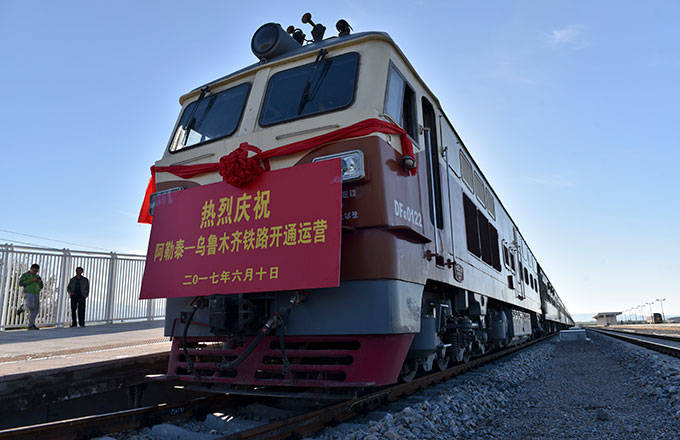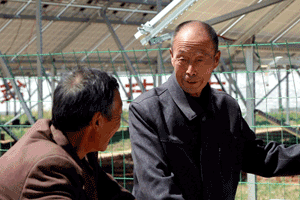Tough times for China's wind energy
Bringing large-scale wind farms to China seems like a fantastic concept, since the nation struggles with electricity shortages and pollution problems. Northwest China has an abundance of wind, too. The business of wind would appear to be a win-win situation for alternative energy investors, the Chinese government and domestic electricity consumers. Yet, some financial turbulence has blown into China's wind energy sector in recent months.
Recharge, the global source for renewable energy news, posts an 'In Depth' report on its website about China's turbine manufacturers, who are feeling the pinch of an industry boom that has stalled. The country's turbine makers are facing their toughest times yet as a slowdown in new projects catches them by surprise.
Recharge quotes Kerry Zhou, the strategy director at Goldwind, China's oldest turbine manufacturer and number two in the market, as saying, "we expected a slowdown, but the foot hit the brake harder than we thought. We had a signal in the fourth quarter, but it became very obvious in the first half of this year."
Zhou added that Beijing's tightening of monetary policy, combined with a wave of accidents at wind farms in Gansu Province; Northwest China is halting the flow of new project approvals. "A few months ago, we said growth would be flat. Now we think it will probably be negative growth compared with last year," Zhou said.
China's leading manufacturer of wind turbines, Sinovel, reported negative net cash flow from operating activities of 1.9 billion yuan, despite a rise in sales of 20%.
According to Recharge, "a series of accidents in Gansu Province has also hit new projects. In three separate incidents, hundreds of turbines were disconnected from the grid after voltage dips. The State Grid halted approvals for new projects for a period of 'about two months.' The restriction has since been lifted, but Zhou says it 'postponed a lot of projects and will impact the whole market growth."
Goldwind said that the company endured bleak financial conditions throughout the first half of the year. It reported a 17% decline in first-quarter profits and warned the first half could bring a further drop of up to 50%.
Wind farm accidents in Gansu caused major disruptions to China's power grid, while Beijing just announced the State Electricity Regulatory Commission (SERC) will conduct nationwide inspections this month of wind power facilities after a series of large-scale disconnections that threatened the stability of the power grid, as reported by the China Daily on August 5. Government agencies will inspect wind farm safety management, operations, and grid connections as well as wind turbines.
The SERC is blaming the absence of Low Voltage Ride Through (LVRT) systems in the facilities as the primary cause of these failures. LVRT systems allow wind turbines to continue operating during and after voltage dips so the grid can adjust more quickly, which improves overall grid safety and stability.
"LVRT systems are required under the standards of China's largest power distributor, the State Grid Corp, which is in charge of power integration," as reported by the China Daily. However, installing LVRT on a wind turbine means more expenses. It costs between 10,000 yuan ($1,538 U.S. dollars) and 500,000 yuan to upgrade a single wind turbine to be LVRT-compliant, depending on the turbine model, which would reduce profit margins for wind turbine manufacturers.
Installing this equipment may seem like an effective way to avoid future problems, but small companies that manufacture wind turbines will struggle to pay the additional costs. Anyway, does this equipment guarantee that wind turbine operators would never again experience a voltage dip that jolts the power grid? Perhaps not, as revealed by Qin Haiyon, secretary-general of the China Wind Energy Association. He told the China Daily, "the absence of LVRT systems is not the only possible reason for the system failures."
Nevertheless, there's still strong potential for growth for China's wind energy sector, especially in Gansu Province. The province is scheduled to have 10 gigawatts (gW) of installed wind capacity, compared with the 5.5gW it produced in 2010.
The People's Daily noted that Gansu Province contains the potential for additional wind capacity of 200gW. Gansu's wind power development has transformed into a model story in China, where 32 massive wind farms are located and the region has turned into a popular site for wind power developers in China.
According to the China Daily, "the grid in Gansu is being built out in conjunction with generation facilities. Connected wind power contributes 16% of the total power generated in Gansu, compared with a national average of 1.2%."
Hence, China's wind energy has been struggling with turbulence this year, but a bright outlook for the sector remains in the forecast. Every industry has dealt with ups and downs in the market, but China's wind energy won't get blown away by a bad turn of events so long as it adapts to changing economic and political conditions. China still needs wind farms to produce energy to meet growing domestic demand.
- China issues guidelines to develop 'all-for-one' tourism demonstration zones
- Torrential rain triggers disaster in Southwest China
- Harvest time for wheat reapers in Shanxi
- Over 200 couples marry in Changchun group wedding
- Calligraphy tops other icons of Chinese culture, WeChat data shows





















